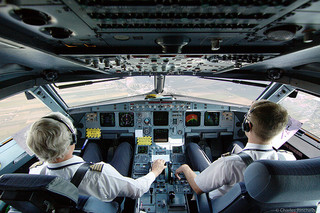
One of the inevitable results of traveling around the country is getting used to airline employees, especially flight attendants, talking to me–often reciting governmentally- or corporately-mandated scripts about safety or the rich benefits of airline credit cards. The presentations range from stultifying to (occasionally) hilarious. It’s fun to hear creative staff riff on the means of fastening seat belts or the use of oxygen masks.
What I’ve begun to notice is that, increasingly, pilots are weighing in not just on our altitude, flight time, or the Grand Canyon off to the left, but with thanks for choosing whatever airline I happen to be on at the moment and concern for the passenger experience. While this may not be new, my memory being what it is (or, more accurately, isn’t), it does seem interesting. Flight attendants, and arguably gate agents, sign on for jobs focused on customer service. It is my assumption that pilots on the other hand take their jobs because they love to fly, not because they love to get people to Grandma’s house (or yet another conference). To those for whom that is true, the existence of passengers may at best a necessary evil.
“Fish got to swim, birds got to fly.”
From Showboat: “Can’t Help Lovin’ Dat Man”
by Jerome Kern and Oscar Hammerstein
You see where I’m going with this, right? Few of my fellow passengers are on the plane with me because they, like the pilots, love to fly. Most, I would assume, are on the plane as a means to an end. They could choose another airline, drive, take a bus or train. And if none of those options work for them, they could stay at home and not miss the “joy of flying.” The fact that pilots are now talking to passengers about their concerns indicates a conscious awareness that without the passengers, the airline and its jobs for pilots, attendants, mechanics, etc. would not exist. There is a symbiotic relationship among all of us that airline personnel ignore to their peril. Particularly, the fact that the motivation to consume the product is not the same as the pilots’ for flying is OK.
There are many reasons, beyond a pure love for the arts, that people attend arts events–to be seen, to connect with friends, to improve oneself. The list is long. The fact that their reasons for attendance are not the same as ours for presenting the event does not demean them. It should not demean us. Sure, we want everyone to get art the way we do, but that’s not going to happen. Recognizing that any attendance is an exchange of value–their time and, often, money for our event–should prompt us to focus as much as possible on their interests and satisfaction. This is audience engagement–deepening relationships with current participants.
Community engagement applies this principle to groups of people who have not yet gotten on the plane. But we can’t address their reasons if we don’t seek to know them. That takes communicating (especially listening), finding ways to serve their needs or interests, and letting them know we are doing so.
[Caveat, yet again: Community engagement is not “giving them what (we think) they want.” It does demand learning enough about “them” to know what work of the international cultural canon will be meaningful to them. And then programming that with them.]
Like airline pilots, we must realize that whatever the motivation of those at our events, their continued presence and therefore the quality of their personal experience are important to us and to our organizations. A different way of thinking for some, but a critical one nonetheless.
Engage!
Doug
Photo:![]()
![]()
![]() Some rights reserved by hugokernel
Some rights reserved by hugokernel
